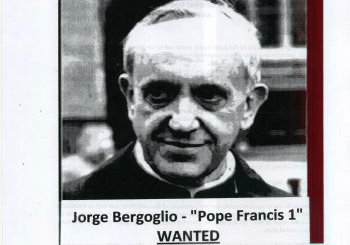EIR Daily Alert Service
|
FRIDAY, FEBRUARY 3, 2017 Volume 4, Number 24 EIR Daily Alert Service P.O. Box 17390, Washington, DC 20041-0390
EDITORIALOnly Principle Is RealFeb. 2 (EIRNS)—Rep. Marcy Kaptur’s press-conference yesterday re-introducing Glass-Steagall legislation, occurred simultaneously with the Trump Administration’s renewal of its commitment to Glass-Steagall, in answer to a question posed by EIR correspondent Bill Jones. For those who have seen it, that press conference marked a total break from the deluge of corrosive hyper-partisanship being led by ousted murderer Barack Obama himself, and fuelled with millions of dollars of George Soros’s drug-money. Here instead were patriots seeking to unite the House of Representatives, and unite it with the Senate and the Presidency, in behalf of a critical immediate step of vital national interest, and in fact of vital world interest. Lyndon LaRouche’s forecast of the end of the two-party system, at his 90th birthday celebration in 2012, has effectively come to pass. (Remember, after all, that the American voters defeated the Republican Party just as much as the Democratic Party in the recent election.) Instead of representatives of parties, what we saw at yesterday’s press conference were simply leading individuals—individual leaders—regardless of party affiliation. Marcy Kaptur began the press conference by welcoming President Trump’s support of Glass-Steagall, and volunteering to work with him to get it enacted. Rep. Tulsi Gabbard had met with President-elect Trump, and then flown to Syria to meet with President Bashar al-Assad, in part because she knows that the issues are simply too important to refuse any meeting with anyone who might bring a solution closer. Rep. Walter Jones told the poignant story of his two greatest mistakes: his vote supporting repeal of Glass-Steagall in 1999, and his subsequent vote to support the second Iraq war. Once he realized how profoundly wrong these both had been, he has devoted the remainder of his life to righting those wrongs, or to remission of these sins. As Aleksandr Solzhenitsyn once wrote, “There is nothing that so assists the awakening of omniscience within us, as insistent thoughts about one’s own transgressions, errors, mistakes.” The meaning and the purpose of this unity of the Houses of Congress with the President and the people goes beyond Glass-Steagall, which is only an indispensable first step. Its meaning and purpose is LaRouche’s “Four Laws” of June 2014. Those Four Laws are an indissoluble unity. They are the principle without which nothing will work; this nation can only be saved by men and women of principle—and this is the principle. “This is what’s real,” as LaRouche said today. The rest is chatter. Former Reagan Administration official Paul Craig Roberts, who has rightly supported President Trump against the calumnies of Obama and the Soros golems, wrote in a recent column that he fears that the Trump Administration may not be able to carry out its plans. That would be true, but for Lyndon LaRouche and his Four Laws—along with the new creative discoveries which LaRouche will introduce in the future. As he said recently, “I’ve done this before, and I can do it again.” At her press conference, Representative Kaptur was given the signatures of 700 Ohioans on a petition-letter to President Trump for Glass-Steagall, which she will pass on to him. As agreed in a telephone-call with Lyndon and Helga LaRouche today, all LaRouche activists will be encouraged to circulate this petition on hard-copy (from the LaRouche PAC website), so that many thousands more signatures from around the country will go to President Trump through Representative Kaptur and other Federal legislators. And finally, on leadership: Recall that it will take only one U.S. Senator to put a “hold” to stop Steve Mnuchin’s confirmation as Treasury Secretary. Not fifty-one; just one. GLOBAL BATTLE FOR GLASS STEAGALLWall Street, Fake-News Network CNN Alarmed about Glass-SteagallFeb. 2 (EIRNS)—After White House Press Secretary Sean Spicer’s answer to EIR correspondent Bill Jones yesterday, where Spicer reiterated that the President supports Glass-Steagall, “CNN Money” ran a hysterical story today, “Will Trump Break Up the Big Banks?” CNN’s report that JPMorgan’s Jamie Dimon is rushing to Washington to convince Trump not to do it—and that Treasury nominee Steve Mnuchin is lukewarm on the idea—is a colorful display of the alarm spreading through Wall Street that Glass-Steagall is a real threat. Glass-Steagall Coming Soon To Italian Deputies’ Banking CommitteeFeb. 2 (EIRNS)—EIR has learned that by the end of February, the Banking Committee of the Italian Chamber of Deputies might start a discussion of Glass-Steagall proposals. This was prompted by a request by Giorgia Meloni, the leader of a small right-wing parliamentary group, called Fratelli d’Italia (FdI), which has 2% and 9 deputies. Factions have the right to have a number of items scheduled for discussion, which number depends on the size of the group. FdI has the right to push for one item, and remarkably, Meloni pushed for her Glass-Steagall draft bill. Meloni’s text is short, but is preceded by an introduction that refers to 1933 Glass-Steagall Act. There are a total of 12 draft Glass-Steagall bills in the Italian Chamber of Deputies, and hopefully they will all be included in the discussion. M5S financial spokesman Alessio Villarosa has filed a new draft bill, although the M5S had one such bill already. The committee could discuss it and pass a text to be voted in the Chamber, or reject it. The discussion process could also include hearings. The ‘Trump Effect’ in ItalyFeb. 2 (EIRNS)—A so-called “sovereign” front is being formed in Italy, with an eye to the possible early national elections and the idea of putting together all forces which are against the euro and for a return to national sovereignty. The name of the group is “Italia Sovrana” and it is a mixed bag, with populists such as the Lega Nord and Fratelli d’Italia (FdI), but also a faction in Berlusconi’s Forza Italia (although Berlusconi is not yet convinced), and mavericks such as former Economics Minister Giulio Tremonti on the sidelines. This group held a large rally in Rome on Jan. 28. Lega head Matteo Salvini is profiling himself as the candidate for Prime Minister. A Jan. 31 event in Milan showed the potential for turning this populist coalition into something better than a populist revolt. Under the banner “Beyond the euro—becoming great again” (a play on Trump’s slogan), the podium was shared by Lega head Matteo Salvini, economist Claudio Borghi (also Lega Nord), leftist economist Alberto Bagnai, and independent MEP Marco Zanni. Later on, journalist and blogger Marcello Foa was also invited to the podium. Although the event was aimed at raising Salvini’s profile, and the moderator was a shrill populist journalist, the intellectual leadership was de facto taken by Zanni, Bagnai, and Foa. Among other things, Zanni listed four points: 1. Leaving the euro; 2. Bringing the Bank of Italy back under the Treasury; 3. Banking separation; 4. “A large public investment plan in industry, research and above all, with reference to all natural disasters we are going through in Italy, to improve the territory” with infrastructure. It is ridiculous that Italy has spent over €60 billion on the EFSF and ESM for EU bailouts, but is not allowed to spend a cent to save the lives of its citizens. (See EIR Economics Editor Paul Gallagher’s interview with MEP Marco Zanni on Jan. 27, 2017.) NEW GLOBAL ECONOMIC ORDERAbe Will Propose Investment in U.S. Infrastructure, Extends Talks with President TrumpFeb. 2 (EIRNS)—According to the Japanese daily Yomiuri Shimbun, during his scheduled meeting with President Trump on Feb. 10-11, Japanese Prime Minister Shinzo Abe’s “growth and jobs initiative would include a plan for Japan and the United States to jointly develop a $450 billion ‘infrastructure market,’ into which the Japanese government and companies would invest $150 billion over 10 years.” Another report by the Daily Caller News said “among the projects included in the initiative are high-speed rail projects, plans for transportation infrastructure upgrades, technology sharing programs, advanced power generation projects, and other high-end programs.” Reuters is reporting that the visit originally set for Feb. 10, has been extended to Feb. 10-11, with the first day in Washington, and the second day at Trump’s private resort in Mar-a-Lago, Florida. Reuters cited an unnamed Japanese executive saying, “(Abe) wants to know what’s the most important thing for Trump. If it is the trade surplus that Trump cares the most about, for instance, then we could come up with a few possible solutions, including importing more U.S. shale oil or gas. Abe’s approach toward Trump would be accommodating, not opposing,” he said. Japan’s trade surplus with the U.S. was $60 billion in 2016. “While 40% of all Japanese shipments to the U.S. consisted of cars and auto parts, U.S. auto exports to Japan were limited. American cars made up less than a third of 1% of all passenger cars sold in Japan last year,” the Daily Caller News reported. Beijing To Build and Co-Finance Philippine InfrastructureFeb. 2 (EIRNS)—Philippine Finance Secretary Carlos Dominguez detailed the agreements reached during his trip to Beijing in January. He reported to the Business Mirror in Manila, today, that Chinese Commerce Minister Gao Hucheng agreed to seek co-financing with the AIIB, Asian Development Bank, and World Bank for the projects in the Philippines. Three projects named were a $3 billion rail project, connecting Manila to the south to Legaspi City on the Bicol peninsula, and two water projects costing over $400 million. Dominguez gave the Chinese a total of 40 large and small infrastructure projects for possible financing and assistance in conducting feasibility studies during the Jan. 23-24 mission, Business Mirror reported. Of the 40 projects, 15 were for loan financing, and 25 for feasibility-study support. Nine other projects aim to interconnect the country’s three main island-groups; boost tourism; and construct a flood-control system in Mindanao and “ensure its stable power supply.” Nuclear support has not come up as yet. The two countries will hold bilateral meetings to advance the projects. “It makes more sense for us to be closer to our Asian neighbors than to our distant friends,” Dominguez said. During President Duterte’s visit to Beijing last year, $24 billion worth of aid and investment pledges were agreed to by China, in soft loans totaling $9 billion and other economic deals amounting to about $15 billion. India Sets Up Special Account for Development of Chabahar Port in IranFeb. 2 (EIRNS)—Indian Finance Minister Arun Jaitley, during his presentation of India’s annual budget for Fiscal Year 2016-17 on Feb. 1, said India has started a special account for allocation of funds for the development of Iran’s Chabahar Port, Sputnik reported today. The allocation to the account for the year is $22.5 million. “India had received a contract to develop a multipurpose cargo terminal (600 meters length) and a container terminal (640 meters length) at Chabahar port last year in May. The Indian government had agreed to equip both the terminals with equipment worth $85 million. Last year, the Indian government had allocated $15 million for the project. India’s EXIM bank has also promised a $150 million credit for the development of phase 1 of the port, within four months of receiving their application through the Central Bank of Iran. Government sources told Sputnik that it was “awaiting the submission of projects from Iranian side,” Sputnik’s report said. The development of Chabahar will help India gain a foothold in Iran and win access to Afghanistan, Russia and Europe. Last May, India, Iran, and Afghanistan had signed a tripartite agreement to develop the port, which will also have an industrial zone where more than $15 billion is expected to be invested over the years. India’s state-owned rail company, IRCON, has signed an agreement with the Iranian authorities to build a 500 km rail line from Chabahar port on southeastern coast of Iran, to Zahedan, at the cost of $1.6 billion, as part of the transit corridor to Afghanistan. Lavrov Sends Greeting to Tillerson on His Taking Office as Secretary of StateFeb. 2 (EIRNS) – Russian Foreign Minister Sergey Lavrov has sent a message of greetings to U.S. Secretary of State Rex Tillerson, on the occasion of his taking office as Secretary of State. “Lavrov sent a message of greetings to the newly appointed U.S. Secretary of State to voice the hope for better relations,” a Russian Foreign Ministry source told TASS. The source said that Moscow-Washington relations “suffered great setbacks during the Obama administration.” He said, “We have quite a few areas for cooperation to the benefit our peoples and the whole world.” As for a first meeting between the two top diplomats, the source said: “We consider that… such a meeting will be held, and first of all this may be possible at various international events if Minister Lavrov and State Secretary Tillerson happen to be there simultaneously.” “So far, there are no agreements on the meetings, but of course, when the foreign ministers of Russia and the U.S. happen to be together at any international forum, they may contact each other in this or that way, there is no doubt of that. We should wait and see if this is a separate meeting, or just shaking hands in a corridor,” he said. He did not rule out a possible meeting on the sidelines of the Munich Security Conference in Munich, Germany, on Feb. 17-19. The G20 will also hold its foreign ministerial meeting on Feb. 16-17 in Bonn. Meanwhile the head of the North America Department at the Russian Foreign Ministry, Georgy Borisenko, commented on the constructive atmosphere developing between Russia and the new U.S. administration, according to another TASS report. Speaking at a roundtable on the Russian-U.S. relations under the new U.S. administration held at the Federation Council, the upper house of Russia’s legislature, Borisenko recalled the two telephone conversations between Vladimir Putin and Donald Trump, Nov. 14 and Jan. 28. “The willingness of the U.S. side to work together in a business-like manner, without phobias and for mutual interests, was felt,” Borisenko said. “This determination is already seen in contacts with Trump’s team. “Over the past years of Barack Obama’s Presidency we almost got unaccustomed to this. It should be stated that since 2012 the Obama administration started ruining the foundation of cooperation,” he said. STRATEGIC WAR DANGERUkraine Continues Provocations, Sends Military Plane To Buzz Russian Black Sea Oil RigsFeb. 2 (EIRNS)—The Ukrainian regime sent what could have been a kamikaze flight of Antonov-26 transport to buzz two Russian drilling rigs in the Black Sea at low altitudes. Russian Defense Ministry officially protested to the Ukrainian military attaché in Moscow over the obvious provocation. “On Wednesday night (Feb. 1), the Ukrainian military attaché was summoned to the Defense Ministry where he was handed a note,” Defense Ministry spokesman Gen. Igor Konashenkov told reporters, according to TASS. “The ministry offered a protest to the attaché over an incident where an Antonov-26 turboprop of the Ukrainian Army made two runs-in at Tavrida and Krym-1 drilling rigs at a minimal admissible altitude, which jeopardized the safety and security of their personnel,” he said, specifying that the incident occurred between 23:30 and midnight Moscow Standard Time (UTC/GMT +3). “The note says the Russian side sizes up the actions of the Ukrainian plane as a provocation,” General Konashenkov said. The Defense Ministry dismissed the Ukrainian official’s claims about gunfire, which Russian forces had allegedly opened at the turboprop, as an absolute lie. During the second target run of the plane, a guard at one of the oil rigs shot up four flares from a signal pistol to prevent the turboprop from colliding with the jackknife of the rig. Putin Explains the Kiev Regime’s Escalation in the DonbassFeb. 2 (EIRNS)—Russian President Vladimir Putin, in Budapest, for meetings with Hungarian Prime Minister Viktor Orban, explained the reasons behind the escalation of violence in southeast Ukraine, reports Sputnik. “The first reason is that the Ukrainian leadership needs money. And it is better to ask the EU, European states, the U.S. and international institutes for money while presenting itself as a victim of aggression,” Putin explained. Secondly, during last year’s election campaign in the United States, the Kiev regime supported a “certain female candidate,” but now, “they need to mend ties with the current U.S. administration amid a conflict. It’s always easier to drag the current [U.S.] administration into solving Ukrainian problems and establish a dialogue this way.” The third reason for the escalation is an internal one. “Amid [Kiev’s] obvious failures in its social and economic policies, the [Ukrainian] opposition intensified its activity. They want to hush it up by mobilizing the population around the leadership. It’s easier to achieve this goal amid the resuming of a conflict,” Putin said. Trump Administration Evaluating Options with Respect To IranFeb. 2 (EIRNS)—White House National Security Advisor Michael Flynn issued a statement yesterday, and later appeared at a White House briefing, in which he claimed that Iran had tested a missile in violation of UN Security Council resolutions, and therefore, “We’re putting Iran on notice.” He connected Iran’s missile test to a Yemeni attack on a Saudi naval frigate in the Red Sea on Jan. 30. Later in the day, White House officials appeared at a background briefing, in which they repeated the dubious charges levelled by Flynn, but then made other, more reasonable statements. According to Reuters, they said a range of options was being considered, including economic sanctions, and that a broad review of the U.S. posture toward Iran was being conducted. One official said the intent of Flynn’s message was to make clear the administration would not be “shy or reticent” toward Tehran. “We are in the process of evaluating the strategic options and the framework for how we want to approach these issues,” the official said. “We do not want to be premature or rash, or take any action that would foreclose options or unnecessarily contribute to a negative response…. Our sincere hope is that the Iranians will heed this notice today and will change their behavior,” he said. SCIENCE AND INFRASTRUCTUREPutin in Hungary Promises Two Nuclear Power UnitsFeb. 2 (EIRNS)—Visiting Hungary, Russian President Vladimir Putin, following his talks with Hungarian Prime Minister Viktor Orban today, said Russia and Hungary have agreed to step up cooperation in nuclear power, including the Paks nuclear power project. “In particular, we agreed to step up joint work in the energy sphere,” Putin said, adding that Russia attached great importance to the project for building two new reactors at the Paks NPP plant worth €12 billion, which is under way. When the project is completed, the capacity of the Paks NPP will double, TASS reported today. TASS also noted Putin “did not rule out Russia may fully finance construction of two units…. It means 10,000 extra high-technology jobs with good salaries, reliability improvement and work for future development of the Hungarian economy on the whole,” Putin said. In addition, Hungary’s Minister of Foreign Affairs and Trade Peter Szijjarto said today after meeting with Russian Minister of Industry and Trade Denis Manturov in Budapest, that “Hungary and Russia will form closer cooperation in heavy industry developments in technology-intensive sectors,” Budapest Business Journal reported. Szijjarto also said that both sides have agreed on continuing Hungary’s and Russia’s cooperation in the area of space research. He also noted “the success of Hungarian farm technology investments in Russia,” and spoke about incentives for the construction of Hungarian water management systems in the country. |
|
















